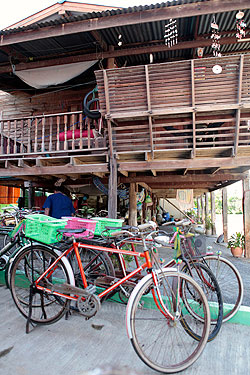
By Ajarn Helen Jandamit
Photos courtesy of Bangkok Post
University Tips is here to help you prepare for the English exams and tests that are coming your way. It gives you practise answering questions similar to those you may have at school and also on the University Entrance Examination.
Read the following story from the Bangkok Post. Then, answer the questions that follow.
Dozens of old bicycles for rent are kept under Amporn Leesuksam’s wooden house and in her concrete courtyard. Amporn is the village head of Ban Khok, in the U Thong district of Suphan Buri.
“Ban Khok has been home for us, the Lao Khrang ethnic group, since our ancestors immigrated from Luang Prabang in Laos to the kingdom during the early Rattanakosin period,” Amporn said.

The ethnic group is called Lao Khrang or Tai Khrang because they use lac insects (or khrang in Thai), to dye yarn and cloth.
Their traditional costume is dark red in colour. Some groups might wear a red blouse or shirt, while others might wear a red phasin (tube skirt). For some groups, all their clothes are red. In Ban Khok, formal attire is a woven cotton, long-sleeved red blouse with a Mandarin collar and long black skirt with a red lower border.
Amporn usually wears indigo-dyed cotton cloth, as it is comfortable in the hot weather. She also puts on her favourite cap and wears a red, woven scarf on her shoulder — her work uniform. Once dressed, she is ready to lead us on a tour of her village.
“I will lead you to our traditional Lao Khrang house, our village shrines and the vegetable plantations and rice fields,” she said. “The distance is about 2 kilometres.”
Each of us selects a bike. They are made from steel, and are heavy and durable.
“I started collecting the bikes more than a decade ago because I wanted the younger generations to learn how our ancestors got around the village when there were no cars or motorbikes,” Amporn said.
Amporn’s passion for old bikes led her to start buying them for relatives and friends. When more villagers learned about her initiative, they showed their support by giving her their old bikes. Amporn also has two assistants who help repair bikes. Later she founded a bike club. The oldest bike the club owns is more than 100 years old. It belongs to Amporn, who inherited it from her grandfather, and it still works well. Amporn likes to ride it around the village to meet people.
When representatives from the Designated Areas for Sustainable Tourism Administration (DASTA) visited Ban Khok about two years ago, they saw potential in promoting the village as a tourism spot in U Thong. There were already historical sites in the area dating back 1,800 years. DASTA’s representatives spoke with Amporn, and together they created a biking route and a homestay service for tourists.
“We have welcomed visitors from time to time over the past two years, and I found that most of them love our bikes,” Amporn said. “They have told me that the bikes remind them of the good old days.”
Visitors to Ban Khok are required to pay respect to the village guardians at Hor Chao Nai. According to the village head, the locals still believe in spirits, so they built seven shrines in the central area of the village. The villagers hold an annual ceremony around June to thank the spirits and to ask for good crop yields and good health.
About a 90 minute drive from Bangkok, U Thong might fit the bill for families seeking a weekend trip.
Exercises
Section 1
Read the story and answer the following multiple-choice questions.
1. Where does Amporn Leesuksam keep her bicycles for rent?
a. Under her wooden house.
b. In her concrete courtyard.
c. Both a and b are correct.
2. What does Amporn usually wear?
a. Indigo-dyed cotton cloth.
b. A long-sleeved red cotton blouse.
c. A red blouse or a shirt with a red sarong.
3. When did Amporn’s ancestors immigrate from Luang Prabang?
a. More than a decade ago.
b. During the early Rattanakosin period.
c. 1,800 years ago.
4. How far is U Thong from Bangkok?
a. About 2 kilometres.
b. About a 90 minute drive.
c. The story does not say.
5. Why is Amporn’s ethnic group called Lao Khrang or Tai Khrang?
a. Because they use lac insects to dye yarn and cloth.
b. Because they dye their yarn and cloth blue.
c. Because they keep lac insects as pets.
6. Why did the locals build seven shrines in the central area of the village?
a. Representatives from DASTA told them to.
b. They thought it would attract more tourists.
c. They still believe in spirits.
7. What are visitors to Ban Khok reminded of when they see the bikes, according to Amporn?
a. The village guardians.
b. The good old days.
c. A biking route and a homestay service for tourists.
8. When did representatives from the Designated Areas for Sustainable Tourism Administration visit Ban Khok?
a. About two years ago.
b. About a decade ago.
c. About 1,800 years ago.
Section 2
Read the story and decide whether the following statements are true or false.
9. Bank Khok villagers hold a ceremony in January each year to ask for good crop yields and good health.
………………..
10. Amporn is the village head of Ban Khok.
………………..
11. Ban Khok is located in Ang Thong province.
………………..
12. Lao Khrang is an ethnic group.
………………..
13. Lao Khrang’s traditional costume is dark green.
………………..
Section 3
Fill in the blanks in the following passage with the correct words from the choices given.
After Amporn let me try an old bike, I had …..14….. admit that getting on and off was difficult, as …..15….. bike was quite high. My legs couldn’t touch the …..16……, even when the saddle was adjusted to the lowest…..17….. . I thought the old bike was difficult to ride …..18….. compared to a mountain bike or one with a …..19….. and a passenger seat, like those meant for housewives.

14.
a. two
b. too
c. to
15.
a. an
b. a
c. the
16.
a. handlebars
b. seat
c. ground
17.
a. volume
b. level
c. price
18.
a. when
b. with
c. so
19.
a. basket
b. basset
c. brisket
Section 4
Read the following sentences and underline the grammatically correct word in each from the choices given.
20. They assisted tourists from time to/in/on time.
21. Her family have lived in Thailand since their ancestors immigrated in/near/from Nepal.
22. The bikes reminded me off/of/for the good old days.
23. These bikes are used to carry/carrying/carriage heavy loads.
24. Some villager/villagers/villages wear a red blouse.
Vocabulary
-
ancestor (n): a person in your family who lived a long time ago
shrine (n): place where people come to worship because it is connected with a holy person or event
plantation (n): a large area of land where crops are grown
durable (adj): likely to last for a long time without breaking or becoming weaker
potential (n): the possibility of something happening or being developed or used


